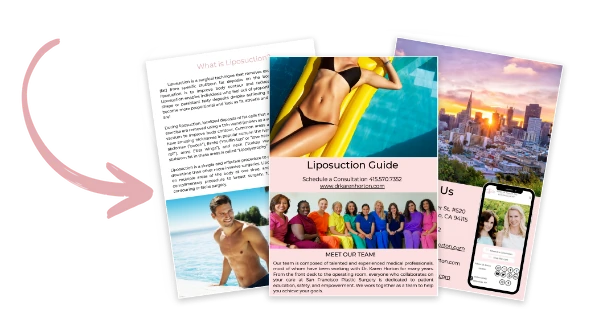Dr. Karen Horton has either authored or reviewed and approved this content.
Page Updated:
Liposuction, also referred to as “lipo”, is a highly effective body contouring procedure designed to permanently remove stubborn fat deposits from targeted areas that do not respond to diet and exercise.1 Many individuals struggle with localized fat in areas such as the abdomen, thighs, flanks, arms, and under the chin despite maintaining a healthy lifestyle. If you are looking for a solution to sculpt and refine your body’s natural contours, liposuction can provide long-lasting results.
During this surgical procedure, localized deposits of fat cells are removed using a thin wand (known as a surgical “cannula”) and a vacuum to improve body contour. Common areas amenable to liposuction have amusing nicknames in popular culture: the hips, thighs (“saddle bags”), abdomen (“pooch”), flanks (“muffin-top” or “love handles”), buttocks (“banana roll”), arms (“bat wings”), and neck (“turkey waddle”).2 Accumulation of in these areas is called “lipodystrophy” in the medical literature.
Liposuction is a simple and effective procedure to contour the body with less downtime than other more invasive surgeries. Liposuction can be performed on multiple areas of the body at one time and can also be added as a complimentary procedure to breast surgery, tummy tuck surgery, body contouring, or facial surgery.

Ideal liposuction candidates are healthy individuals who maintain a stable weight and have good skin elasticity.3 Both men and women with pockets of fat that persist despite regular exercise and a balanced diet may benefit from this procedure.
Liposuction is most effective for those who have reached their optimal body shape but struggle with isolated fat deposits that are resistant to weight loss. It’s important to note that liposuction is not a substitute for weight loss.4 For the best results, patients should be at or near their goal weight, and those planning significant weight loss or pregnancy may want to postpone the procedure until their body has stabilized.
Patients who are on GLP-1 medications such as Ozempic, Wegovy, Mounjaro, Gardiance and others for weight loss or diabetes should have completed their weight loss journey before having liposuction and should plan to be off these medications prior to planning surgery. GLP-1 medications must be stopped a full month before any surgery under general anesthesia to avoid complications. Learn more about how to stay safe when taking diabetic or weight loss medications including semaglutides in this blog post.
Please see our Preparing for Surgery section to learn more about optimizing your results from liposuction by becoming the best possible candidate for surgery.
Hi Dr. Horton, just want to reiterate how much I loved having you as my doctor. Looking at those past pictures of myself then looking in the mirror I was speechless! I adore my new fit and healthy body! Thank you again so much for all you do!!
„The traditional liposuction technique, also called suction-assisted lipectomy (SAL), is the most common approach for fat removal. Before surgery, targeted fat deposits are marked while standing to ensure precise contouring. The procedure includes injecting tumescent liposuction, where a specialized solution containing normal saline (sterile saltwater), epinephrine (adrenaline), and lidocaine is first injected to minimize bruising, enhance safety, and improve post-surgical comfort.
For optimal results and patient safety, liposuction of large areas is typically performed under general anesthesia as an outpatient procedure in a fully equipped operating room. While some smaller cases can be done in-office, larger-volume fat removal (over 5 liters or 10 pounds) may require an overnight stay for monitoring.
Ultrasonic liposuction is a multi-step process that uses ultrasound energy to first break down stubborn fat before removal with standard liposuction. Also known as ultrasound-assisted lipectomy (UAL) or “Vaser” liposuction, this method is particularly effective for areas with dense or fibrous fat, such as gynecomastia (male breast tissue) or lipodystrophy related to certain medications. By softening fat before extraction, UAL can improve contouring in challenging treatment areas.
Another machine that is occasionally used has a vibrating wand that purports to decrease surgeon fatigue and help the cannula travel through dense areas. Known as “power-assisted liposuction” (PAL), this technique is not commonly performed in our practice.
New machines and technologies emerge on the market every year. Many of these have brand names that are heavily promoted in the media and on large billboards to the general public – and are usually NOT performed by Board-Certified Plastic Surgeons. While these procedures often have familiar brand name recognition, there is no guarantee that they are appropriate for every patient in every situation, and are not offered in our office.
In our practice, we only offer procedures and treatments that are FDA-approved, clinically proven, and recommended by our professional societies, which are limited to Board-Certified Plastic Surgeons. For safety and to find the very best fit of procedure to match your specific body contouring goals, a formal in-person consultation, including a complete history and full physical examination, is essential.
Drag the slider to see transformation
Drag the slider to see transformation
Please see our Preparing for Surgery section to learn about what happens in the operating room on the day of surgery.
During liposuction, small (2-3 millimeter) incisions are hidden in natural body creases whenever possible, such as the groin, belly button, armpit, or buttock crease. Through these incisions, a special fluid mixture called “tumescent solution” is infiltrated into the fat. Tumescent solution contains normal saline (sterile salt water), which helps to “plump up” the fat cells for removal, adrenaline (epinephrine), which acts as a “vasoconstrictor” to decrease bruising and prevent bleeding, and a local anesthetic (lidocaine) which makes the area numb for many hours up to a few days after surgery and promotes postoperative comfort.
Next, a blunt-ended, thin-diameter wand known as a “cannula” is introduced through the tiny incisions to gently suction out excess fat using a strong vacuum. Fat cells are removed permanently! The treated areas are “feathered out” at their edges to blend naturally with the surrounding areas. At the end of the procedure, dissolving sutures are placed, and a compression garment is applied. Surgery can take an hour and a half up to several hours if multiple areas are treated.
After liposuction, mild discomfort requiring oral pain medication and swelling are expected for a few days during the healing process. You will be given oral prescription pain medication and can switch to regular Tylenol when you feel ready. Medications such as aspirin, ibuprofen, and other NSAIDs (Excedrin, Motrin, and Aleve) must be discontinued two weeks before and after surgery to limit bruising.
Bruising is expected after liposuction for 2-3 weeks. You will awaken wearing a compression garment. It is recommended you wear your garment continuously for the first 3-5 days after surgery before removing it to shower, as your swelling will peak during this early postoperative period.
You can return to work within a few days and resume exercise in a few weeks or when you feel ready. You should continue to wear your compression garment for up to six weeks after liposuction to promote the flattest and firmest body contour possible. Numbness and overall tiredness are common for a few weeks after surgery.
It can take 3 months up to a year for all surgical swelling to subside and for the final results of liposuction to be apparent. Please see our Postoperative Instructions section for additional information pertaining to recovering from liposuction.

Dear Dr. Horton, Thank you very much for my results from surgery. I feel like I look fantastic and balanced. All my clothes have a whole new meaning and I love getting dressed everyday now.
Please note that pricing will vary, and all information provided represents an average of typical costs and time and does not guarantee pricing or availability. Your individual treatment plan will be personalized to meet your needs, and we recommend scheduling a consultation to receive a more accurate breakdown of pricing and recovery expectations.

What Are the Potential Complications and Risks of Liposuction Surgery?
Please see our Preparing for Surgery section to learn about risks and potential complications related to surgery and Postoperative Instructions for additional information pertaining specifically to liposuction.
Where Can I See Before and After Photographs of Liposuction Procedures?
Visit our patient gallery to see before and after liposuction results!
How Do I Know Whether Liposuction Is Right For Me?
As a woman Plastic Surgeon and a Mom of twins herself, Dr. Karen Horton intimately understands how a woman’s feelings about her body can influence her body image and self-esteem. We aim to give you the results you are looking for, and to ensure you have the very best experience! At your liposuction consultation, Dr. Horton will spend a great deal of time with you to get to know you personally and take a complete medical history. We will explore your reasons for seeking body contouring, examine you, and if you are an appropriate candidate for surgery, your options will be described in detail.
Is Liposuction Part of a Mommy Makeover?
Liposuction is very often part of a Mommy Makeover! Common areas addressed by liposuction include the abdomen, armpits, flanks, pubic region, hips, inner and outer thighs, buttocks, arms, and neck or chin. Please see our Mommy Makeover section to learn about changes that commonly occur in the body after pregnancy and about liposuction as a component of a Mommy Makeover!
Will Liposuction Remove Cellulite?
The body has two main layers of fat: the deep layer, where excess fat is stored, and the superficial layer, which is thinner and found in areas like the face, ankles, and sternum. A connective tissue boundary, composed of collagen and elastin, separates these layers. This tissue structure varies by genetics and differs between men and women.Cellulite forms when fatty deposits in the deep layer push against weak connective tissue, creating a dimpled appearance. This occurs more commonly in women due to naturally looser connective tissue, especially in areas like the buttocks and thighs. While cellulite cannot be removed, its appearance may improve when the deep fat layer is reduced.Liposuction targets stubborn fatty deposits that resist a healthy diet and exercise. It removes fat from the deep layer while preserving the superficial layer to maintain smooth, natural contours. Though liposuction does not eliminate cellulite, it may reduce its visibility by decreasing tension on the skin. After surgery, wearing a compression garment supports even skin contraction and enhances contouring results.
How much does liposuction cost?
The cost of liposuction can vary depending on the treatment area, the complexity of the procedure, and whether it is combined with other cosmetic surgeries. On average, liposuction patients can expect to pay between $8,000 to $15,000 per area.This estimate includes surgical fees, anesthesia, and facility costs. Since every body is unique, the best way to determine the exact cost of your liposuction procedure is to schedule a consultation with Dr. Karen Horton in San Francisco. During your visit, she will assess your concerns, discuss your goals, and create a personalized treatment plan tailored to your needs.
Can I combine any other cosmetic surgery procedures with liposuction?
Many liposuction patients choose to combine their procedures with other cosmetic surgeries for a more comprehensive body rejuvenation. Liposuction can enhance aesthetic results when paired with procedures like abdominoplasty, breast augmentation,
Where can I find liposuction near me?
Dr. Karen Horton offers expert body contouring solutions to patients in the San Francisco Bay Area tailored to your aesthetic goals. As a Board-Certified Plastic Surgeon, Dr. Horton specializes in advanced liposuction techniques to sculpt and refine your body's natural shape while ensuring beautiful, natural-looking results. If you're considering liposuction and want to learn more about your options, contact us today to schedule a consultation at our San Francisco practice.
1 Mayo Clinic. Liposuction. https://www.mayoclinic.org/tests-procedures/liposuction/about/pac-20384586. Accessed March 14, 2025.
2 Cleveland Clinic. Liposuction. https://my.clevelandclinic.org/health/treatments/11009-liposuction. Accessed March 14, 2025.
3 American Society of Plastic Surgeons. Liposuction Candidates. https://www.plasticsurgery.org/cosmetic-procedures/liposuction/candidates. Accessed March 17, 2025.
4 American Society of Plastic Surgeons. Liposuction. https://www.plasticsurgery.org/cosmetic-procedures/liposuction. Accessed March 14, 2025.
Dr. Karen Horton has either authored or reviewed and approved this content.
Give us a call or fill out form below to schedule online.
Monday-Friday: 9am - 5pm
Saturday-Sunday: Closed
Monday:
9 AM to 5 PM
Tuesday:
9 AM to 5 PM
Wednesday:
9 AM to 5 PM
Thursday:
9 AM to 5 PM
Friday:
9 AM to 5 PM
Saturday:
Closed
Sunday:
Closed
Dr. Karen M. Horton
2100 Webster St., Suite 520
San Francisco, CA 94115
Phone: 415.923.3067
We are located in the
Pacific Heights District
in the Pacific Professional Building.
 SHOP SKIN CARE
SHOP SKIN CARE*Please note: Our office is no longer a Participating Provider for insurance. We can provide a financial quote for what anticipated surgical fees will be after your consultation.